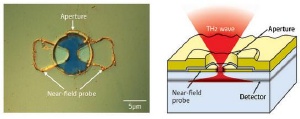Nov 14 2008
Terahertz (THz) radiation is currently attracting considerable interest for imaging and sensing applications, because it has the potential to supersede x-rays that are more damaging. THz radiation, however, has very low energy, which makes it challenging to detect. Now Yukio Kawano and Koji Ishibashi from the RIKEN Advanced Science Institute in Wako have succeeded in developing a high-resolution and high-sensitivity THz detector on a chip.
 On-chip THz detection. (a) Photograph of the on-chip detector consisting of an aperture, a probe layer and detector. (b) Schematic of the electric field propagation through the device. The evanescent field from the aperture is enhanced by the probe layer and guided towards the thin film detector.
On-chip THz detection. (a) Photograph of the on-chip detector consisting of an aperture, a probe layer and detector. (b) Schematic of the electric field propagation through the device. The evanescent field from the aperture is enhanced by the probe layer and guided towards the thin film detector.
THz radiation offers several advantages over x-rays. As the energy of light is very low, THz radiation is less damaging to materials. Similarly, THz radiation is strongly absorbed by water, which means that soft tissue of the human body can be imaged by THz rays. For these reasons, THz imaging and detection is in strong demand in fields as broad-ranging as biosensing and food inspection.
So far, the lack of compact and efficient detectors has hampered the widespread use of THz imaging schemes. The high-resolution on-chip THz detection scheme the researchers report in the journal Nature Photonics* is based on a technique that uses a small aperture and a probe (as a type of antenna) for THz radiation. Like planar water waves that move through a narrow slit and are converted into circular waves, THz radiation propagating through the aperture forms dense ‘evanescent waves’.
As evanescent waves decay rapidly in intensity with increasing distance from the aperture, prior designs, where the detector was away from the aperture and/or the probe, had poor detection sensitivities. “In our approach, the detector is integrated with the aperture and the probe, which enables us to directly detect the evanescent wave itself,” says Kawano commenting on the advantages of the design.
The aperture resides within a thin gold film through which the THz radiation passes. The evanescent waves are then enhanced within the narrow gap of a bow-tie shaped gold probe layer before reaching the detector. The detector itself consists of thin semiconductor films with a highly mobile layer of electrons that efficiently absorb THz radiation.
The overall integration of all components on a single chip ensures a simple and robust detection scheme. Indeed, in the first test runs, the researcher achieved high detection efficiencies with a resolution of 9 µm—significantly smaller than the THz wavelength of 215 µm, which is far beyond the possibilities of conventional optics. Therefore, simple and robust devices based on the present design are expected to have a significant impact on the further development of THz imaging technology.
- Kawano, Y. & Ishibashi, K. An on-chip near-field terahertz probe and detector. Nature Photonics 2, 618–621 (2008).